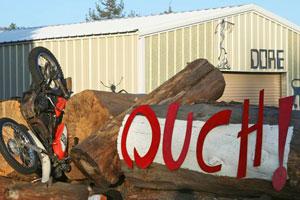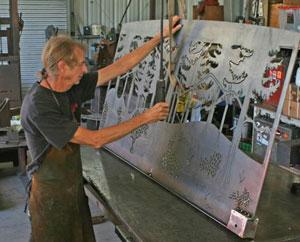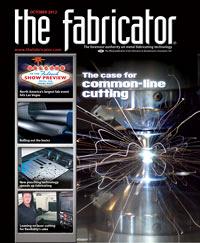- FMA
- The Fabricator
- FABTECH
- Canadian Metalworking
Categories
- Additive Manufacturing
- Aluminum Welding
- Arc Welding
- Assembly and Joining
- Automation and Robotics
- Bending and Forming
- Consumables
- Cutting and Weld Prep
- Electric Vehicles
- En Español
- Finishing
- Hydroforming
- Laser Cutting
- Laser Welding
- Machining
- Manufacturing Software
- Materials Handling
- Metals/Materials
- Oxyfuel Cutting
- Plasma Cutting
- Power Tools
- Punching and Other Holemaking
- Roll Forming
- Safety
- Sawing
- Shearing
- Shop Management
- Testing and Measuring
- Tube and Pipe Fabrication
- Tube and Pipe Production
- Waterjet Cutting
Industry Directory
Webcasts
Podcasts
FAB 40
Advertise
Subscribe
Account Login
Search
The art is just a front
Sculptor spends more time making dies, fixtures than making art
- By Eric Lundin
- October 9, 2012
- Article
- Bending and Forming
Dore Capitani cut right to the chase: "My wife says the art is just a front." Maybe so. The former industrial mechanic, who worked his way up to master mechanic, spent the early part of his career working for a packaging manufacturer, and later for a glass container manufacturer, and learned how machines and dies do what they do. This sort of background comes in handy now that he's plying his trade as a metal artist, trying to figure out how to bend metal to his will.
Industrial Heartland to Pacific Paradise
Capitani's hometown, Kenosha, Wis., isn't exactly a sprawling Midwestern industrial metropolis, but indeed it's midway between two prominent manufacturing cities: Milwaukee and Chicago. For a young man growing up in Kenosha in the late 1960s, when manufacturing accounted for nearly 30 percent of all private-sector U.S. jobs, a manufacturing career was a natural choice. It was a good run, more than 20 years, but in the early 1990s, the manufacturing sector was changing. The North American Free Trade Agreement (NAFTA) was enacted in 1994; Capitani attributes the big change in his life path directly to NAFTA. His career came to an abrupt end when his employer shut down its Chicago plant and moved it to Mexico, but he and a friend struck out on their own, making mailboxes. This doesn't sound too lucrative, but it was.
"Our clients were people who owned zillion-dollar homes," Capitani said. The average price for one of their mailboxes was $1,500. That gig lasted several years, but eventually the demand dried up. Capitani's marriage likewise foundered, and his future didn't look too bright.
Everything changed when he got a call from an old girlfriend. On a trip to the West Coast to see her, Capitani found himself in Idyllwild, Calif., thinking about purchasing an 8-acre property that had a lot of potential. Serendipitously, the property's price tag matched the amount of money he had left over from his divorce settlement. "It was almost to the dollar," Capitani said. "I think it was fate."
Immersed in Inspiration
Kenosha isn't a bastion of Native American culture, but nevertheless Capitani cites Native American art as a big influence in his work. "I have always been fascinated by petroglyphs," he said, referring to the rock carvings commonly seen in the southwestern U.S. (see Figure 1).
Recalling his days of making high-end mailboxes, Capitani said he still fabricates similar high-dollar projects when he can. Some projects are purely artistic, some are functional, but all of them are decorative in some way. He once made a $6,500 downspout.
However, he isn't solely focused on upscale projects. His claim to fame is something less pricey: decorative spheres (see Figure 2). A concept that lends itself to infinite variations, spheres are rewarding because they are both unique and challenging.
"I always start with new metal, never scrap or found metal," he said. "I use 1⁄8- or 3⁄16-in. plate, and after cutting the shapes, I use an ironworker and custom-made dies to get the right radius." Using an old propane tank that he cut open to make a form, he lays out the parts and clamps them in place with locking pliers. "I use about 40 sets of Vise-Grip®s," he said.
Welding the first few parts is easy, but it gets progressively difficult as the sphere gets closer to completion. In fact, putting a torch to the metal is just a small part of making a sphere. Cutting and bending the shapes, laying them out in the form, clamping them, and figuring out how to get the torch into tight spots take up much more time than the actual welding.
"It's 95 percent preparation and 5 percent application," Capitani said.

Figure 1: Finding inspiration in petroglyphs, or rock carvings, Capitani creates figures in a similar motif in metal.
While making the next sale is a primary motivation for every artist, Capitani takes time out for non-revenue-generating activities too. For example, his shop is located next to a steep, twisting road that poses a challenge for many drivers, and, well, accidents happen. He posted a big sign to remind passersby to drive carefully (see Figure 3).
A Bit of California Cool
Capitani can't say enough good things about the location. "I'm in heaven," he said. But it isn't just his 8 acres; it's the West Coast mindset, which he has found to be open-minded and progressive. It wasn't long before the newcomer found himself part of the community, both as a businessman doing repair welding and as an artist with pieces on public display along El Paseo, a prominent boulevard in nearby Palm Desert. Likewise, he contributes to the community whenever he can, most recently when he donated some time, effort, and the use of his powder-coating booth to make a sign for a local playground. It's a virtuous cycle.
"The more you give, the more you get back," he said.
Dore Capitani, 28815 State Highway 243, Mountain Center, CA 92561, 951-659-0791, dorecap@gmail.com, www.doresmountainartgarden.com. All photographs courtesy of Trish Tuley.

Figure 3: After Car and Driver named the road in front of Capitani’s shop one of the best in the U.S. for its steep inclines and sharp curves, Capitani noticed an increase in traffic. He placed some timbers in front of his shop to protect it from errant cars and motorcycles, then installed a crashed motorcycle as a graphic reminder to stay in control.
About the Author

Eric Lundin
2135 Point Blvd
Elgin, IL 60123
815-227-8262
Eric Lundin worked on The Tube & Pipe Journal from 2000 to 2022.
subscribe now

The Fabricator is North America's leading magazine for the metal forming and fabricating industry. The magazine delivers the news, technical articles, and case histories that enable fabricators to do their jobs more efficiently. The Fabricator has served the industry since 1970.
start your free subscription- Stay connected from anywhere

Easily access valuable industry resources now with full access to the digital edition of The Fabricator.

Easily access valuable industry resources now with full access to the digital edition of The Welder.

Easily access valuable industry resources now with full access to the digital edition of The Tube and Pipe Journal.
- Podcasting
- Podcast:
- The Fabricator Podcast
- Published:
- 04/16/2024
- Running Time:
- 63:29
In this episode of The Fabricator Podcast, Caleb Chamberlain, co-founder and CEO of OSH Cut, discusses his company’s...
- Trending Articles
AI, machine learning, and the future of metal fabrication

Employee ownership: The best way to ensure engagement

Steel industry reacts to Nucor’s new weekly published HRC price

Dynamic Metal blossoms with each passing year

Metal fabrication management: A guide for new supervisors

- Industry Events
16th Annual Safety Conference
- April 30 - May 1, 2024
- Elgin,
Pipe and Tube Conference
- May 21 - 22, 2024
- Omaha, NE
World-Class Roll Forming Workshop
- June 5 - 6, 2024
- Louisville, KY
Advanced Laser Application Workshop
- June 25 - 27, 2024
- Novi, MI



























